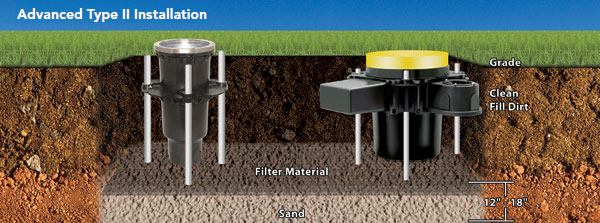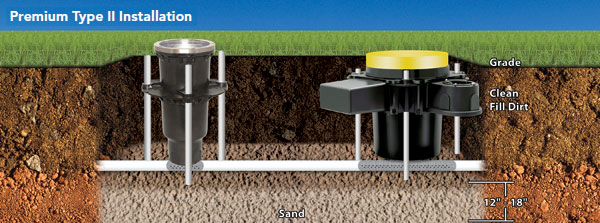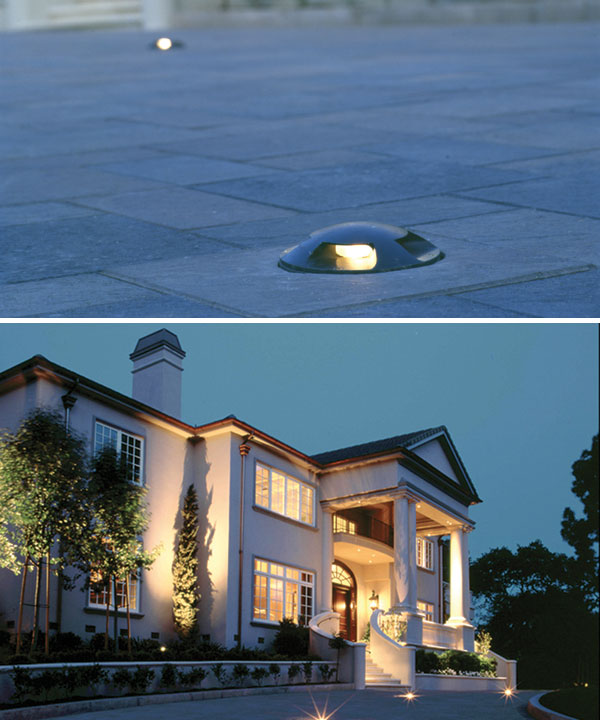Best Practices for Site Preparation and Installation of In-Grade Fixtures
The natural ability of the soil to drain water away from the surface, and away from the luminaire, is a powerful ally in keeping the recessed in-grade luminaire a little drier, but different types of soil drain water away with varying degrees of proficiency. It is the texture of the soil, its composition of gravel, sand, silt, and clay, that determines how quickly water will drain through the soil, also referred to as drainage. Sandy and granular soils typically drain water quickly from the surface. Soils with larger compositions of silt and clay tend to drain more poorly and, as a result, remain soggier or constantly saturated, posing more of a threat to the longevity of the recessed in-grade luminaire.
Identifying Soil Type
Before selecting a specific recessed in-grade luminaire, best practices recommend first identifying the type of soil present at the project site. Soils have been classified into two distinct groups, Type I and Type II, as it relates to a soil's ability to drain.
Type I describes a soil that is an easy or free draining soil. In general, this type of soil has very little or no clays and may have a sandy feel or appearance. Type II describes a soil that has more difficulty draining. In many cases, even small amounts of water will pool and can take hours or days to drain away from the surface. Typically, this type of soil consists of varied amount of clay or hardpan, which inhibits subsurface drainage.
The Soil Type Test
Determining whether the soil on a project is Type I or Type II is a fairly straightforward process. There is a simple test that will reveal the soil type in two hours. First, dig a hole at least 18 inches in diameter and 18 to 24 inches deep. Then fill half of the hole with water and track how long it takes for the water to drain into the soil. If complete drainage occurs in less than two hours, the soil is Type I. If complete drainage takes more than two hours, the soil is considered Type II.
Matching Installation Practices and Soil Type
The type of soil available on a project heavily influences how the recessed in-grade luminaire should be installed in order to reduce the fixture's exposure to standing water. While it is generally understood that the contractor will need to provide some type of drainage during installation, there are different ways to create drainage and these different approaches can deliver very different results. A technique that provides adequate drainage on one project may provide terribly insufficient drainage in another, ultimately creating a problematic installation. It is critical to match the site-specific drainage needs with the installation technique that will provide the necessary degree of drainage.
Installing In-Grade Fixtures in Type I Soil
Type I soil is considered a preferred site condition with ideal drainage properties. No additional installation practices are required if the project site offers Type I soil. However, review the Other Installation Considerations section on the next page, because different installation practices may be recommended in certain site-specific situations including areas covered in concrete, planter areas and walkways, and areas subject to heavy rainfall.
Installing In-Grade Fixtures in Type II Soil
There are three different installation practices recommended for installing recessed in-grade fixtures in Type II soil. They are a Standard Type II installation, an Advanced Type II installation, and a Premium Type II installation. Once an installer determines that the project site hosts Type II soil, the degree of drainage support necessary can be determined by assessing the prevalence of water in the location of the installation. Irrigation systems designed to water the area, a downspout draining into the vicinity of the installation, or a topography that slopes down toward the in-grade fixture location would all indicate that greater degrees of drainage should be provided to protect the functionality of the system.
Standard Type II installation. Over-excavating is the critical piece of a Standard Type II installation. This over-excavation creates an opportunity to backfill the excessively large hole with a material that drains better than the Type II soil readily available at the jobsite. Sand is the most highly recommended material. Backfilling with gravel, rock, or crushed rock should be avoided, because geotechnical research indicates that a migration of fine soil particles to this coarser backfill will occur over time, which could cause the ground around the fixture installation to sink, settle irregularly, or shift. Compacted sand does not allow for the migration of adjacent soil particles, preventing problematic soil settlement without compromising the installation of the fixture.
Specifically, the Standard Type II installation recommends that the installer create a hole for the housing that is 12 to 18 inches deeper than required by the fixture. The additional depth is then backfilled with moistened sand that is compacted into the space. The sand is easily adjusted to maintain the proper grade for the installation of the recessed in-grade fixture housing.
Placing an effective filter between the fixture housing and the sand backfill is the second critical component of a Standard Type II installation. Prior to the final setting of the housing, it is recommended that a filter material, such as a porous landscape fabric, be placed between the sand and the bottom of the housing. This filter will help keep sand out of the bottom of the open or vented fixture housing, without inhibiting the self-draining properties of the outer housing.
Advanced Type II installation. The Advanced Type II installation expands the excavation for the in-grade fixture system by pairing the additional depth of the Standard Type II installation with a trench between the fixture housings. The trench helps to facilitate the drainage of water away from the surface by removing the poorly draining soil from the immediate surrounding area of the fixture.

An Advanced Type II installation creates a trench between the fixture housings to facilitate the drainage of water away from the surface.
The connecting trenches should also be over-excavated and backfilled with moistened sand. A filter material should also be placed between the sand and the bottom of the fixture housing, allowing water to migrate down through the sand and away from the fixture, without allowing the sand to work itself up into the luminaire, potentially clogging the fixture housing.
Premium Type II installation. The Premium Type II installation, commonly referred to as a French Drain, also requires over-excavation, a sand backfill, trenching and further increases drainage on the project with the addition of a subsurface perforated pipe. The perforated pipe can be PVC or another type of gravity sewer pipe that is used for landscape drainage.

A Premium Type II installation further increases drainage on a project site by adding a subsurface perforated pipe, commonly referred to as a French Drain.
Drainage pipes can be pre-perforated or perforated in the field, but they should contain perforations at the 8:30, 10:30, 1:30, and 3:30 positions, when the pipe is placed directly under the housing. The perforations allow the water to migrate down through the sand and leach into the pipe for swift evacuation. The pipe should be at least 3 inches from the bottom of the sand backfill or 3 inches from the bottom of the fixture housing. A continuous pipe can be constructed and positioned to aid the drainage of multiple housings. Beyond the perforations, the pipe should also be wrapped with filter material so the sand backfill does not clog the drainage system.
The drainage pipe will need to maintain a sufficient grade difference to ensure that the collected water flows to the outlet and does not remain sitting in the pipe. A minimum slope of 0.15 percent is generally considered sufficient to promote adequate drainage. Optimum drainage will be achieved if the pipe is installed at ½ percent slope (0.5 foot of drop per 100 feet) or greater.
Other Installation Considerations
The presence of concrete, walkways, buildings, and other landscape and architectural features can materially affect how water travels through an environment, regardless of soil type. Some elements, like concrete, for example, may offer the installation area additional protection against super-saturation, while the presence of other items, such as a building's downpipe, irrigation systems, or the rain-heavy climate of the location may warrant additional drainage as a prudent precaution.
Concrete. If the lighting fixtures are being installed in concrete and there is a minimum of 5 feet between the lighting fixtures and nearby soil, Type I installation practices are recommended, because concrete protects the nearby soil from saturation and the presence of standing water may not be an environmental factor.
Planter areas and walkway. If the lighting fixtures will be installed between a walkway and another structure, such as a building or sidewalk, Type II installation practices are recommended to better manage the water that will run off of the pavement and onto the dirt where the fixtures are installed.
Areas subject to heavy rainfall. In areas that receive heavy rainfall, such as Seattle, Advanced or Premium Type II installation practices are recommended unless the existing soil demonstrates good Type I characteristics.
A word about clean gaskets. While poor drainage is the predominant cause of water ingress that leads to the failure of an in-grade fixture, poorly sealed gaskets are the next most common cause of water-related damage. To avoid leaky gaskets, it is critically important that the gaskets and the surface areas they are attempting to seal are clean. The presence of any grit, dust, or grime can interfere with the formation of a watertight seal, compromising the integrity of the gasket. Contractors should clean the gaskets and adhering surfaces before installation to ensure a tight and effective fit.
Selecting the Right In-Grade Fixture for a Project
Well lights and direct burial lights are two of the most popular types of recessed in-grade luminaires. Here is a closer look at the similarities and differences between these two fixture types, a few of the features that are unique to in-grade fixtures, and some general recommendations on the types of applications that may be best suited for each.
Well Lights
A well light is designed to allow water to pass through the fixture and drain into the soil below. The optical compartment inside the fixture housing is sealed, keeping water from the electrical components that would be damaged by water exposure, but the outer housing is vented and often referred to as a flow-through housing, because it allows water to drain from the surface and flow through the fixture.
Well lights are often installed in areas that require surface water drainage, such as tree grates. In a tree grate application, the luminaire can be integrated into the drain system and uplight the tree too.
Well lights should never be installed in applications where there is no drainage or poor drainage, because if the water is unable to drain out of the fixture, it will sit in the fixture and eventually cause the fixture to fail. If a well light is to be installed on a project where the soil is not permeable, a draining system will need to be installed.
Direct Burial Lights
Direct burial lights do not offer a method for draining surface water. These fixture housings are completely sealed and self-contained, designed for installation in concrete or soil. Despite being completely sealed, providing adequate drainage at each fixture is still a recommended practice, because extended exposure to saturated soil or submersion increases opportunities for the fixtures to leak and increases the risk of fixture failure.
Direct burial lights are often used to illuminate building perimeters surrounded by a sidewalk or to uplight structures such as flagpoles, sculptures, and monuments, because the direct burial lights can be installed into the sidewalk or the concrete base that is often poured to support these elements.
Recessed In-Grade Luminaire Features
Recessed in-grade fixtures are installed in the ground, flush with the grade. This elevation poses unique environmental challenges not faced by a luminaire installed above the ground. Fortunately, fixtures are being developed with features designed to better accommodate the elements. Some well lights and direct burial lights can be designed to withstand complete submersion in water, for short periods of time, to keep the temperature of the lens low enough to touch, and to hold up when driven over by an SUV.

Photos by Douglas A. Salin
TOP: Direct burial lights are completely sealed and do not offer a pathway to drain surface water in this San Francisco private residence.
BOTTOM: Recessed in-grade fixtures in driveways and parking decks can be drive-over rated to withstand the weight of an automobile.









